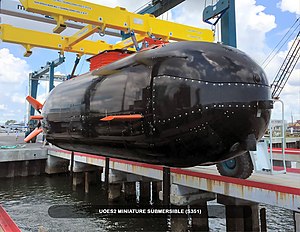 The prototype Dry Combat Submersible
| |
| Class overview | |
|---|---|
| Builders | Lockheed Martin |
| Planned | 3[1][citation needed] |
| Building | 2[1][citation needed] |
| General characteristics | |
| Type | Submersible |
| Displacement | 28 tonnes |
| Length | 12 metres (39 ft) |
| Beam | 2.4 metres (7.9 ft) |
| Draft | 2.4 metres (7.9 ft) |
| Propulsion | Electric motors, lithium-ion batteries |
| Speed | 5 knots (5.8 mph; 9.3 km/h) |
| Range | 60 nautical miles (69 mi; 110 km) |
| Endurance | 24 hours |
| Test depth | 100 metres (330 ft) |
| Complement | 2 crew, 8 SEALs |
| Sensors and processing systems | Sonar, fathometer |
The Dry Combat Submersible (DCS) is a midget submarine delivered to USSOCOM by Lockheed Martin. Lockheed Martin were nominated as the prime contractor with Submergence Group as the sub contractor. DCS is designed for use by the United States Navy SEALs for insertion on special operations missions. It will replace the canceled Advanced SEAL Delivery System and will serve alongside the Shallow Water Combat Submersible.[2]
As the name suggests, the Dry Combat Submersible has a dry interior, enabling longer mission durations in colder water. The DCS is designated the S351 Nemesis.[3]
Lockheed Martin and the Submergence Group were awarded the $166 million, 5-year contract to develop and build three DCSs in June 2016. By 2018, the total spent on the submersibles rose to $236 million.[4] The DCS reached initial operational capability in May 2023, with 2 submersibles completed and delivered to the US Navy.
- ^ a b Cite error: The named reference
Burgesswas invoked but never defined (see the help page). - ^ McRaven, William (March 14, 2015). Hearing on National Defense Authorization Act for Fiscal Year 2015 and Oversight of Previously Authorized Programs Before the Committee on Armed Services, House of Representatives, One Hundred Thirteenth Congress, Second Session (PDF). Subcommittee on Intelligence, Emerging Threats and Capabilities Hearing on Fiscal Year 2015 National Defense Authorization Budget Request from the U.S. Special Operations Command and Posture of the U.S. Special Operations Forces. Washington, DC: Government Printing Office. Retrieved January 23, 2019.
- ^ "S351". Submergence Group | MSubs. 27 March 2018. Retrieved 30 June 2019.
- ^ Ernst, Douglas (September 15, 2016). "SEALs soon using new 'dry combat submersibles' on 'can't fail' missions". The Washington Times. Retrieved 2 March 2019.